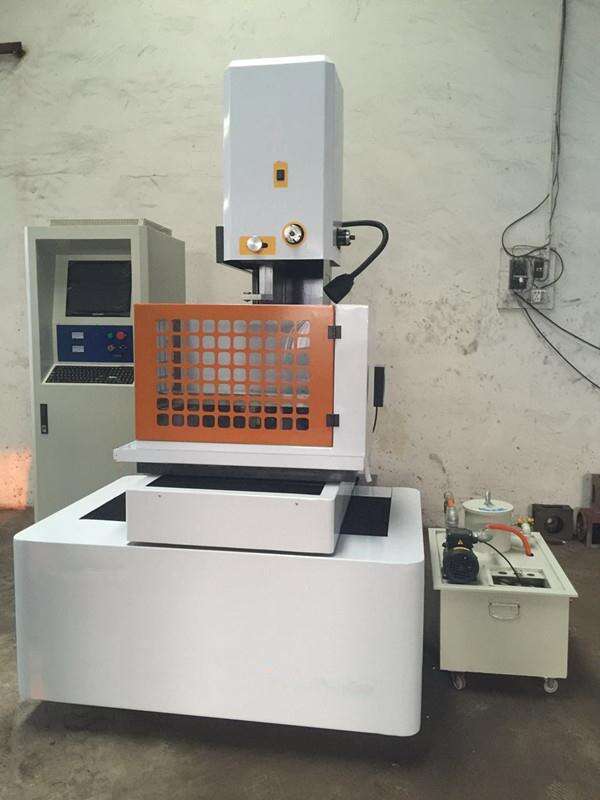Արտադրության արդյունավետության հեղափոխումը առաջադեմ սիմային EDM տեխնոլոգիայի միջոցով
Արտադրության գործընթացները տասնամյակների ընթացքում զգալիորեն էվոլյուցիա են կրել, և wire EDM (էլեկտրաէրոզիոն մշակում) գտնվում է ճշգրիտ կտրման տեխնոլոգիայի առաջատար շարքում: Այս բարդ մշակման մեթոդը փոխել է արդյունաբերության մոտեցումը նյութի օպտիմալացմանը և թափոնների նվազեցմանը: Հաղորդակից նյութերի միջով մանրաթելիկ ճշգրտությամբ կտրելու համար օգտագործելով բարակ, էլեկտրալիցքավորված սիմ ՝ wire EDM-ն ապահովում է նյութի օգտագործման աննախադեպ վերահսկողություն՝ պահպանելով մասերի արտադրության բացառիկ ճշգրտություն:
Ժամանակակից արտադրամասերը ավելի ու ավելի են դիմում սպիտակեղյան EDM լուծումներին՝ նյութի թափոնների և արտադրության ծախսերի նկատմամբ աճող մտահոգությունները լուծելու համար: Տեխնոլոգիայի կարողությունը ձեռք բերելու բարդ կտրվածքներ նվազագույն նյութի կորուստով դարձրել է այն անգնահատելի գործիք տարբեր արդյունաբերություններում՝ ավիատիեզերականից մինչև բժշկական սարքավորումների արտադրություն: Սպիտակեղյան EDM-ի ներդրման հասկանալը թափոնների նվազեցման մեջ պահանջում է ավելի խորը ուսումնասիրություն դրա գործառնական սկզբունքների և գործնական կիրառությունների վերաբերյալ:
Թուղթի էլեկտրաէրոզիոն մշակման գործընթացի տեխնիկական հիմքը
Թուղթի էլեկտրաէրոզիոն մշակման գործընթացի հասկացությունը
Թուղթի էլեկտրաէրոզիոն մշակումը իրականանում է ճշգրիտ էլեկտրական պայթյունների միջոցով, որտեղ բարակ թելային էլեկտրոդը, սովորաբար պղնձից կամ պղնձանիկից պատրաստված, ստեղծում է վերահսկվող կերպով առաջացող պայթյուններ, որոնք քայքայում են մշակվող մասի նյութը: Այս անհպական կտրման մեթոդը վերացնում է ֆիզիկական լարվածությունը և նյութի կորուստը, որոնք բնորոշ են ավանդական մշակման մեթոդներին: Թելը երբեք չի դիպչում մշակվող մասին, այլ ստեղծում է միկրոսկոպիկ էլեկտրական պայթյունների շարք, որոնք նյութը հեռացնում են բարձր աստիճանի վերահսկողությամբ:
Կտրման գործընթացը տեղի է ունենում դիէլեկտրիկ հեղուկում, սովորաբար դեիոնացված ջրում, որը օգնում է պահպանել ճշգրիտ ջերմաստիճանի վերահսկում և հեռացնել հեռացված նյութի մասնիկները: Այս բարդ մոտեցումը թույլ է տալիս կտրել 0,004 դյույմ լայնությամբ, ինչը զգալիորեն նվազեցնում է կերֆի կորուստը համեմատած սովորական կտրման մեթոդների հետ: Թելիկի EDM-ի ճշգրտությունը նշանակում է, որ մասերը կարող են նախագծվել նվազագույն նյութական թույլտվությամբ, ինչը նյութի օգտագործումը օպտիմալացնում է սկզբից:
Բարձրակարգ կառավարման համակարգեր և ծրագրավորում
Ժամանակակից թելիկի EDM սարքերը ներառում են բարդ CNC համակարգեր, որոնք թույլ են տալիս ճշգրիտ վերահսկել կտրման պարամետրերը: Այս համակարգերը թույլ են տալիս օպերատորներին օպտիմալացնել կտրման ուղիները, նվազագույնի հասցնել նյութի թափոնները և ստանալ բարդ երկրաչափական ձևեր, որոնք հնարավոր չէ ստանալ ավանդական մշակման մեթոդներով: Ծրագրավորման հնարավորությունները երաշխավորում են, որ յուրաքանչյուր կտրում հաշվարկված է նյութի առավելագույն օգտագործման համար՝ պահպանելով պահանջվող հանգույցները:
CAD/CAM ծրագրային ապահովման ինտեգրումը թելային EDM համակարգերի հետ թույլ է տալիս արտադրողներին մոդելավորել կտրման գործողությունները արտադրությունը սկսելուց առաջ: Այս նախնական պլանավորումը օգնում է նույնականացնել նյութի կորստի հնարավոր հատվածները և օպտիմալացնել կտրման ռազմավարությունները՝ նյութի առավելագույն օգտագործման համար: Կտրման ճանապարհները վիրտուալ դիտելու և կարգավորելու հնարավորությունը վերացնում է ծրագրավորման սխալների պատճառով առաջացած թանկարժեք նյութի կորուստը:

Նյութի պահպանման առավելություններն ու ռազմավարությունները
Կտրման անցքի լայնության և նյութի կորստի նվազեցում
Թելային EDM-ի կիրառման հիմնական առավելություններից մեկը նյութի կորստի կրճատման ոլորտում նրա նվազագույն կտրման անցքի լայնությունն է՝ կտրման ընթացքում հեռացված նյութի քանակը: Ավանդական կտրման մեթոդները հաճախ նշանակալի նյութի կորուստ են առաջացնում՝ լայն կտրման ճանապարհների և կոպիտ մակերեւույթների պատճառով, որոնք պահանջում են լրացուցիչ մշակում: Թելային EDM-ի ճշգրիտ կտրումը հեռացնում է միայն անհրաժեշտ նվազագույն նյութը, որը հաճախ լայնությամբ 0.012 դյույմից պակաս է, ինչը ժամանակի ընթացքում հանգեցնում է զգալի նյութական խնայողությունների:
Տեխնոլոգիայի կարողությունը պահպանելու կտրման լայնության հաստատունությունը ամբողջ գործընթացի ընթացքում ապահովում է կանխատեսելի նյութի օգտագործում և թույլ է տալիս մասերի խիտ տեղավորում: Այս հաստատունությունը թույլ է տալիս արտադրողներին օպտիմալացնել նյութի դասավորությունը և առավելագույնի հասցնել մասերի քանակը, որոնք կարող են ստացվել հունձանյութի մեկ կտորից, ինչը զգալիորեն նվազեցնում է թափոնների չափը:
Բազմաաստիճան կտրման հնարավորություններ
Գերարդյունավետ թելային EDM համակարգերը ունեն բազմաառանցք կտրման հնարավորություններ, որոնք թույլ են տալիս բարդ երկրաչափական ձևեր մշակել մեկ կարգավորման մեջ: Այս հնարավորությունը վերացնում է բազմաթիվ գործողությունների կարիքը և նվազեցնում է նյութի կորստի ռիսկը՝ կապված սխալ կերպով կամ կարգավորումների միջև անհամապատասխանությամբ կատարված գործողությունների հետ: Բարդ կտրումները մեկ գործողությամբ ավարտելու հնարավորությունը նաև նվազեցնում է հետագա մշակման կարիքը, ինչը հետագա կերպով նվազեցնում է նյութի կորուստը:
Այս բարդացված կտրման հնարավորությունները թույլ են տալիս արտադրողներին ստեղծել գրեթե վերջնական ձև ունեցող մասեր, որոնք պահանջում են նվազագույն վերջավոր մշակում: Երկրորդային մեքենայական обработման կարիքը նվազեցնելով կամ վերացնելով՝ լարային EDM-ն օգնում է պահպանել նյութը, որը հակառակ դեպքում հեռացված կլիներ լրացուցիչ մշակման ընթացքում:
Թափոնների նվազեցման իրականացման ռազմավարություններ
Նյութի դասավորության և խմբավորման օպտիմալացում
Արդյունավետ նյութի օգտագործումը սկսվում է մասերի դասավորության և խմբավորման ռազմավարական պլանավորումից: Լարային EDM կիրառությունների համար նախատեսված արտադրական խմբավորման ծրագրաշարը օգնում է արտադրողներին օպտիմալ կերպով դասավորել մասերը հումքի սահմաններում: Այս համակարգված մոտեցումը ապահովում է նյութի առավելագույն օգտագործումը՝ պահպանելով կառուցվածքային ամրության և ճիշտ կտրման գործողությունների համար անհրաժեշտ տարածությունը:
Արտադրողները կարող են հետագայում նվազեցնել թափոնները՝ միևնույն հումքի մեջ միավորելով տարբեր չափերի և ձևերի մասեր: Այս խառը մասերի կոնստրուկցիայի մոտեցումը նյութի օգտագործումը առավելագույնի է հասցնում՝ փոքր մասերը տեղադրելով այն տարածքներում, որոնք հակառակ դեպքում կդառնային թափոն: Թելային EDM կտրման ճշգրիտ բնույթը երաշխավորում է, որ մասի որակը կմնա հաստատուն՝ անկախ կոնստրուկցիայի բարդությունից:
Պահպանում և գործընթացի վերահսկում
Կանոնավոր պահպանումը և ճիշտ գործընթացի վերահսկումը կտրման օպտիմալ արդյունավետությունը պահպանելու և թափոնները նվազագույնի հասցնելու համար անհրաժեշտ են: Թելային EDM համակարգերը պահանջում են թելի վիճակի, դիէլեկտրիկ հեղուկի որակի և սարքավորումների կարգավորման զգոն հսկողություն՝ կտրման կայուն արդյունավետություն ապահովելու համար: Լավ պահպանված սարքավորումները ավելի ճշգրիտ կտրվածքներ են առաջարկում՝ նվազագույն նյութի թափոններով և փոքրաթիվ մերժված մասերով:
Շատ լավ կերպով իրականացված գործընթացի վերահսկման միջոցառումները օգնում են նյութի կորուստներին հանգեցնող խնդիրները նախապես հայտնաբերելու և ուղղելու: Սա ներառում է կտրման պարամետրերի, լարի լարվածության և պայծառակետի վիճակի հսկում՝ ամենաօպտիմալ կտրման արդյունավետությունն ապահովելու համար: Կտրման տվյալների պարբեշան վերլուծությունը օգնում է օպերատորներին հայտնաբերել միտումները և կանխատեսված կերպով կատարել կարգավորումներ՝ խուսափելու կորուստների պատճառող խնդիրներից:
Հաճախ տրվող հարցեր
Որ նյութերը կարող են մշակվել սալիկաձողային EDM-ով
Սալիկաձողային EDM-ն կարող է մշակել ցանկացած էլեկտրահաղորդիչ նյութ, ներառյալ խորհացված պողպատը, տիտանը, ալյումինը, պղինձը և տարբեր էքզոտիկ համաձուլվածքներ: Նյութի կարծրությունը չի ազդում կտրման հնարավորության վրա, ինչը դարձնում է այն իդեալական կորուստների նվազագույնի վրա բերելով կտրող կարծր կամ ջերմամշակված նյութերի համար:
Ինչպե՞ս է սալիկաձողային EDM-ն համեմատվում լազերային կտրման հետ նյութի կորուստների տեսանկյունից
Քանի որ սաղակի ԷԴՄ-ն ավելի նեղ կտրման լայնություն ունի և կարող է պահպանել կտրման կայուն կատարումը նյութի հաստության ընթացքում, այն սովորաբար ավելի քիչ նյութական թափոններ է առաջացնում, քան լազերային կտրումը: Լազերային կտրման հակառակ, սաղակի ԷԴՄ-ն չի ստեղծում ջերմային ազդեցության գոտիներ, որոնք կարող են պահանջել լրացուցիչ նյութի հեռացում:
Ո՞րն է սաղակի ԷԴՄ-ի ներդրման սովորական դիմադրությունը:
Սաղակի ԷԴՄ-ի ներդրման դիմադրությունը տարբերվում է՝ կախված կիրառման պահանջներից, սակայն շատ արտադրողներ զեկուցում են նշական կտրուկ նվազում նյութի կորստի շնորհիվ, երկրորդային գործողությունների նվազեցմամբ և մասերի որակի բարելավմամբ: Միայն նյութի խնայողությունը հաճախ արդարացնում է ներդրումը շահագործման մեկից երեք տարիների ընթացքում:




